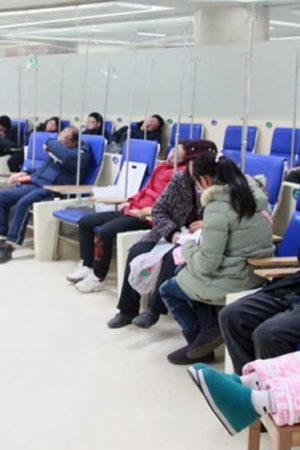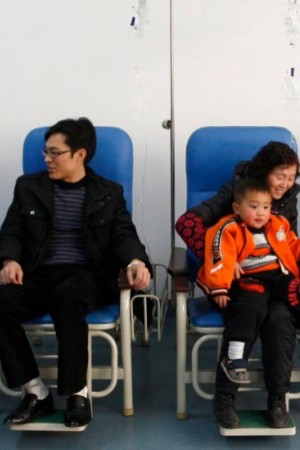Service Innovation for Cataract Care
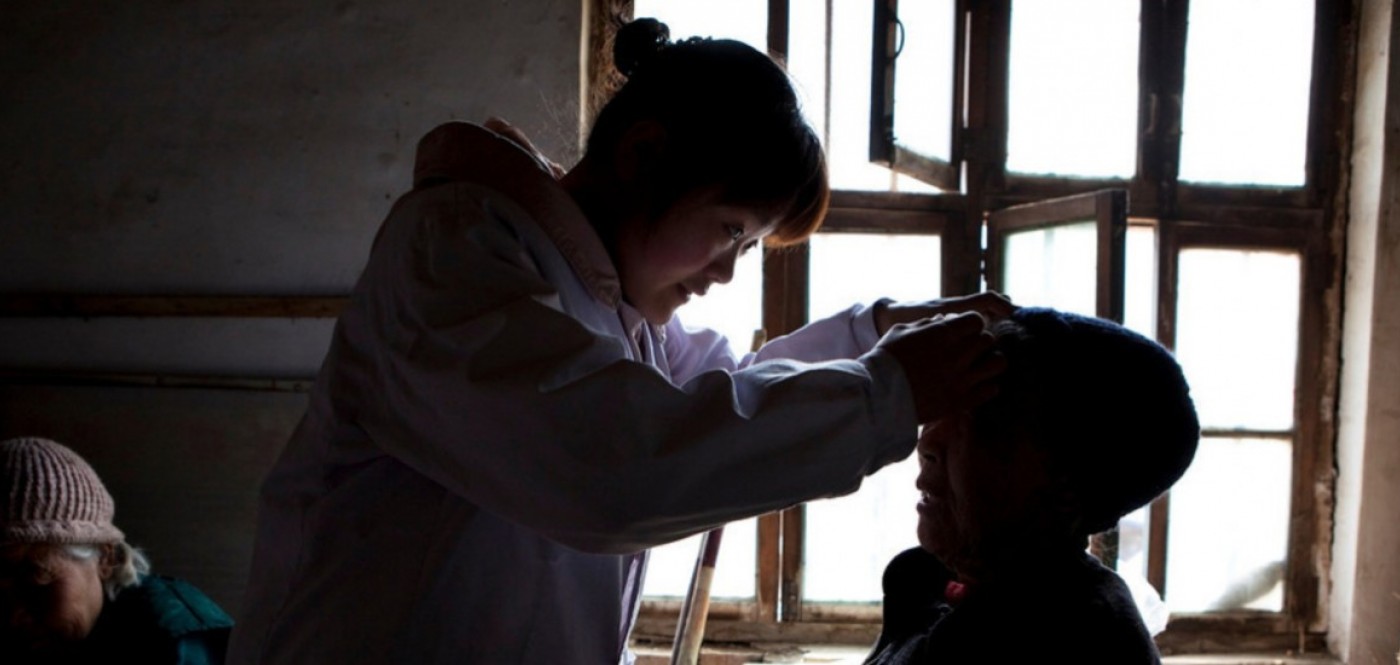
Service localizing and business model innovation for the Chinese rural healthcare market.
BACKGROUND
“Clouds in your Eyes” is a phrase used by doctors in a small village in Shandong province in China to help its local residents, particularly elderly people, to understand cataracts –- an age-related visual impairment disease due to clouding of the lens inside the eye. At present, there are 35 million people diagnosed with cataracts in China. It is regarded as one of the top “messengers of darkness”, accounting for half of the 5.8 million blindness cases. With China accelerating to be an aging society, the number of cataract patients is expected to increase at an 8-10% annual rate.
Barriers for care and the business model do exist.
Despite being an easily curable eye disease, a simple surgery can bring patients back to brightness, many Chinese cataract patients are left out from treatment due to three barriers:
Capacity To Provide Treatment - China has limited capacity to treat cataract patients –- currently, only 450,000 people are being treated per year and there are only 4,000–5,000 qualified eye doctors to perform cataract surgeries.
Patients Are Rural, Doctors Are Urban - 70% of patients are living in rural areas while 80% of the doctors are living in cities. This creates a supply-demand mismatch between physicians and patients.
Awareness of The Disease and Treatments - Finally, most cataract patients are undereducated and have low-income. Many don’t have knowledge about the disease itself, and don’t know how it can be treated or where they can get treatment.
The Opportunity: Providing affordable care to all, through business model innovation.
Witnessing this healthcare blind spot, a non-profit organization named Vision in Practice (ViP) strived to introduce a new business model to serve cataract patients at an affordable price. The concept originated from India and was created to help the numerous grass-roots, private hospitals in towns or counties gain capabilities to treat cataract patients by surgery, so that they can provide safe and secure cataract surgery to the patients who are living in countryside, no matter whether they can afford it or not. It is supposed to be a win-win solution for both cataract patients and the hospitals.
ViP sponsored a small, private hospital called Xin Yi Min, located in Tancheng, Shandong Province, to test the business model. The hospital had established a cataract outreach team to approach residents in remote villages. The healthcare staffs often have to operate in poor conditions, with poor public infrastructures and little support from the local government officials.
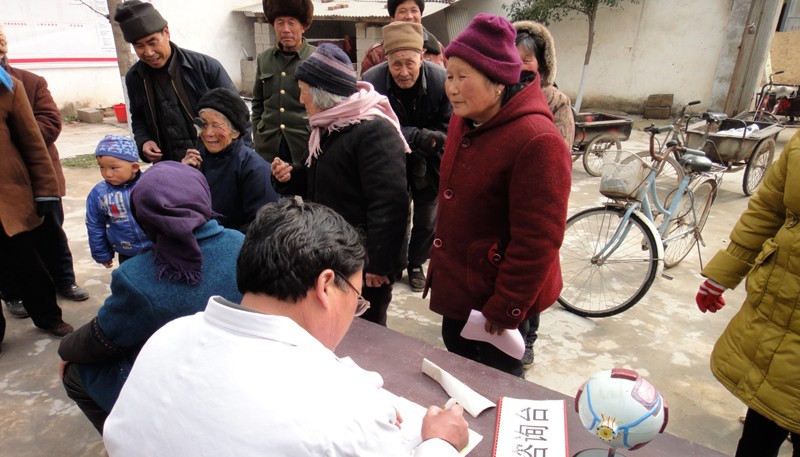
OBJECTIVE
One size does not fit all. You have to take consideration into the social and cultural context as you introduce a product or service into a market.
After one year of piloting, ViP struggled to replicate the program’s success experienced in India. Although the outreach team found plenty of patients who needed cataract surgery, few of them actually came to receive the treatment. Internal data from Xin Yi Min Hospital showed the surgery conversion rate was only around 30% (patients who received surgery, divided by all cataract patients found in the course of their free eye examinations). This low conversion rate greatly concerned ViP because the eye care service’s success is heavily dependent on having enough patients come for surgery in order to achieve break even financially.
As we conversed with ViP, it became clear that social and cultural differences between the Indian and Chinese societies could render their current service strategy ineffective for the local Chinese population. Together with ViP’s team, we defined three urgent objectives that needed to be done to improve the surgery conversion rate:
- Understand the factors that cause cataract patients to choose not to return for surgery;
- Identify weaknesses in the existing service journey; and
- Create a new service strategy to help the program to fit better in China.

PROCESS
A combination of ethnographic research and co-creation to develop a service strategy fitting to the local population
Wherever there are people, there will be services –- they are designed by people, run by people and used by people. Therefore, we believe that the best way to develop a service is to get stakeholders involved throughout the development process, from learning about people’s needs and expectations to the generation and testing of new concepts.
We applied a 4-step process to engage key stakeholders of the medical outreach program –- local villagers, hospital staffs and ViP’s team members.
Reaching Alignment – Stakeholder Interview
We interviewed ViP’s key team members to learn about their experience and challenges of the program. These helped our team and ViP to reach alignment on the project’s objectives and research approach.
Knowing the Reality – Ethnographic Research
We immersed ourselves into the rural town of Tancheng in Shandong province for 8 days and engaged in the activities among patients, nurses and doctors. Using techniques such as participatory observation, in-depth interviews, and shadowing, we captured facts and perspectives about the lives of doctors, nurses and villagers, day-to-day healthcare service operations, and interactions between patients and healthcare staffs. In the process, we built empathy to the key stakeholders of the cataract treatment service.
Interpreting Research Findings – Information Synthesis
After our field research, we analyzed and visualized research data using techniques such as Affinity Diagram and Journey Mapping. These activities helped build a clear view on the existing service journey and the pain points at each stage of the process.
We also organized and facilitated an information synthesis workshop, which our team collaborated with ViP’s key team members to identify insights and opportunities, such as “what are the key barriers that keep patients from returning for treatment”, “how hospital staffs should engage with the local stakeholders”, and “what are the areas that can be enhanced to improve efficiency”.
Co-Creating With Key Stakeholders – Co-Creation Workshop
Our work went beyond presentation of key research findings –- we set up a co-creation workshop and invited hospital staff members to generate new ideas for addressing the shortcomings in their treatment process. This process helped the hospital team to reach alignment on how to better serve their patients. It also allowed the ViP team to better understand how to adjust their core business model to better fit into the Chinese culture.
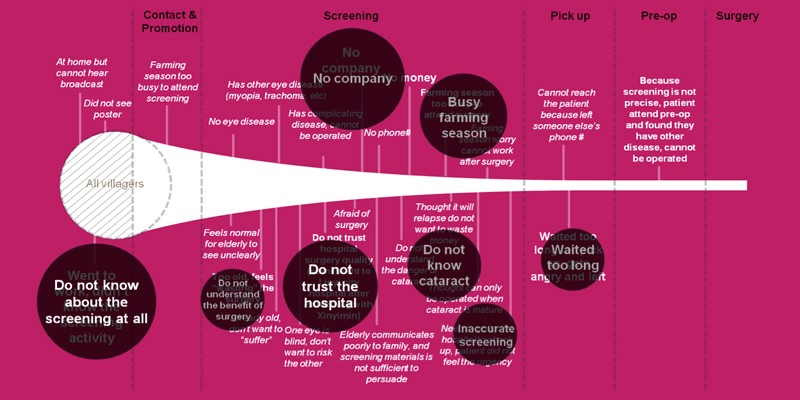
RESULT
Proposing an innovative service strategy that is fitting to the local context by leveraging understanding of current reality
We created a pain point map to summarize the key pain points that led to refusal for surgery in a visual way. The patterns of the pain points also led us to conclude that activities prior to surgical treatment, such as promotion, screening and patient transportation, could directly impact the surgery conversion rate. For instance, one of the key insights was that even after going through the screening process, many patients still didn’t truly understand the causes of cataracts and the benefits of surgical treatment. This insight highlighted the importance of patient education, since many of the elderly in the area are illiterate.
A thorough review of the medical outreach journey helped our team to identify opportunity areas for service enhancement. Combining ideas generated from the co-creation workshop, we proposed new service concepts and strategies to enhance the treatment process. For instance, learning that locals are very busy during a farming session and that different crops have different growing cycles, we recommended that the hospital staff take into consideration the farming period before scheduling their outreach operations.

IMPACT
The enhanced service strategy almost doubled the surgery conversion rate within half a year
Prior to this research engagement, Xin Yi Min hospital had not developed a systematic approach to plan as well as monitor their operations. While they were highly adaptive in handling difficult situations or emergencies, their inputs had not been converted into results in an effective way.
Our work helped Xin Yi Min hospital to build a service strategy framework and allocate resources to better answer the key concerns of the local patients. The hospital team has also become more strategic, doing advanced planning before their outreach operations.
Within six months of adopting our recommendations, Xin Yi Min hospital reported that its cataract surgery rate had increased from 35% to 63%. An increase in patient volume helps the hospital’s ophthalmologists to accumulate experience and skill sets in treating cataract patients.
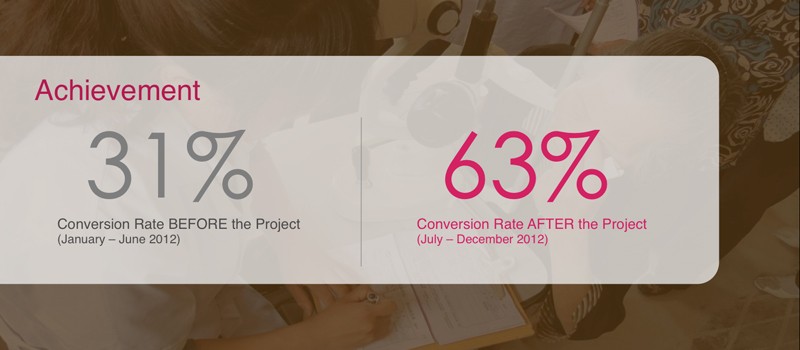
Our research toolkits helped the hospital to build empathy with their patients and evaluate their operation procedures
Xin Yi Min hospital is impressed by our design research toolkits, which helped the hospital to effectively and thoroughly understand their patients and operation procedures. Soon afterwards, with our training and support, the hospital quickly incorporated our methodology into their operation evaluation process.
Building a foundation to help spreading Vision In Practice’s operation model to the nation
Our work had helped ViP to identify the key barriers that prevented successful adoption of the cataract medical care program. With modifications to the principal operation model, ViP can now better engage local communities in various parts of China.

